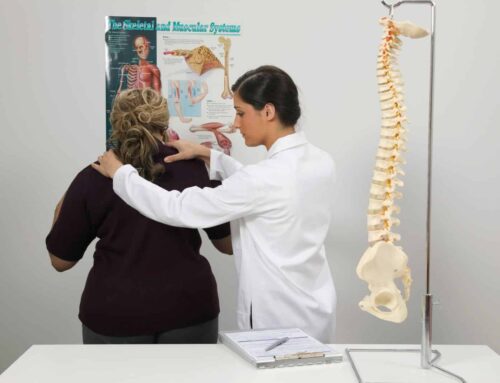
As a common low back problem, sciatica can cause a great deal of discomfort and disruption to daily life. It’s a condition that affects people from all walks of life, from active athletes to those with a more sedentary lifestyle. This fact sheet is designed to provide you with a comprehensive overview of sciatica, its common causes, and how chiropractic care may offer a path to recovery.
In this article, Dr. Simon Nash (Chiropractor) discusses the various causes of sciatica and the different approaches a chiropractor might take to help with the symptoms.
Please note: The information provided in this article is for general knowledge and informational purposes only, and does not constitute medical advice. It is essential to consult with a qualified healthcare professional for a diagnosis and personalised treatment plan.
- Understanding Sciatica
- Common Causes of Sciatica
- The Chiropractic Approach to Sciatica
- Understanding the Healing Process
- Exercises to help prevent sciatica
- Frequently Asked Questions (FAQs)
- Book a Consult with Our Chiro Brisbane
- Video Transcript
Understanding Sciatica
Sciatica is a term that describes a set of symptoms, most notably pain that radiates along the path of the sciatic nerve. This nerve is the largest in the human body, extending from the lower back through the hips and buttocks and down each leg.
“Sciatica is characterised by pain or nerve pain that runs down the leg,” explains Dr. Nash. “It can run from the top of the buttock all the way down to the foot, or anywhere in between, and any combination of that.”
The pain can feel like a dull ache, a sharp, shooting pain, or a burning sensation. In some cases, it can also be accompanied by tingling, numbness, or muscle weakness in the affected leg or foot. This can make even simple activities like walking, sitting, or standing difficult.
Common Causes of Sciatica
Understanding the root cause of your sciatica is the first step towards effective treatment. Dr. Nash identifies three of the most common causes:
1. Disc Bulge
A disc bulge, often referred to as a herniated or slipped disc, is a frequent culprit behind sciatica. This occurs when one of the soft, gel-like discs that cushion the vertebrae in the spine pushes out of its normal position.
Dr. Nash highlights the common location for this issue: “The most common causes of sciatica are a disc bulge. So that can be, for example, from the lumbar spine, the lower lumbar spine.” He notes that a bulge from a lumbar vertebra, such as L5, can affect one or both legs depending on its position. A posterior-lateral disc bulge impacts one side, while a central bulge can compress both nerve roots, leading to radiating pain down both legs.
2. Facet Joint Pain
The facet joints are small joints at the back of the spine that provide stability and allow for movement. When these joints become irritated or inflamed, they can also cause referred pain that mimics sciatica.
“The joints that make up the lumbar spine are called the facet joints,” Dr. Nash explains. “They can get irritated as well. And the patient would typically have pain that runs down to their knee, usually stops around their knee, but it can sometimes overflow a little bit lower.”
3. Piriformis Syndrome
The piriformis is a large muscle located deep in the buttock, connecting the lower spine to the top of the thigh bone. The sciatic nerve runs beneath this muscle (and for some, directly through it). If the piriformis muscle becomes tight, inflamed, or goes into spasm, it can compress the sciatic nerve, causing what is known as piriformis syndrome.
“The piriformis is a big muscle that sits in the low part of the buttock and it will actually compress the sciatic nerve, and that is called piriformis syndrome,” says Dr. Nash.

The Chiropractic Approach to Sciatica
A chiropractor’s approach to treating sciatica is centred on identifying the underlying cause and developing a personalised treatment plan. Since the causes are varied, the treatment must be too. A study in the Journal of Orthopedics and Sports Medicine found that chiropractic spinal manipulation can be an effective treatment for chronic low-back pain, with some patients experiencing a reduction in pain comparable to that achieved with medication.
A treatment plan may involve a combination of different techniques, as Dr. Nash describes in the above video: “We would use a combination. We would use some rehabilitation exercises. We would gently mobilise around the spine using manual adjustment. We could use some taping methods whether it be Kinesio taping or rigid taping.”
Reducing Inflammation: When a disc bulge or facet joint is the culprit, the primary goal is often to reduce inflammation around the affected area. Gentle adjustments, soft tissue therapy, and cold laser therapy can be used to achieve this. A review published in the Journal of Pain Research highlights the potential of low-level laser therapy (LLLT) to reduce pain and inflammation by stimulating tissue repair. “When patients are in quite a bit of pain, we can also use a pain-free laser called a cold laser therapy,” Dr. Nash explains.
Restoring Function: For conditions like piriformis syndrome, the focus shifts to restoring the function and flexibility of the muscle. This can involve targeted stretches, trigger point therapy, and massage to release tension and reduce pressure on the sciatic nerve.
Rehabilitation Exercises: Regardless of the cause, a key component of chiropractic care is providing patients with exercises to do at home. These exercises are designed to strengthen the core and supporting muscles, improve posture, and prevent future recurrences.
Understanding the Healing Process
The time it takes to recover from sciatica can vary significantly from person to person. As Dr. Nash notes, “With the different causes of sciatica, we will find that there’s different healing times with that or treatment times.”
“Sometimes it can be really fast. You could have an irritation that’s gone within a week. You could have an irritation that sometimes takes 6 to 8 weeks to go away.”
The goal of treatment is not just to provide temporary relief but to address the root cause of the nerve irritation. By restoring proper function and reducing inflammation, a chiropractor aims to help the body heal itself. “We want to make sure that that irritation to the nerve and the reason that nerve is being irritated is taken away, or that function is restored,” says Dr. Nash.
This approach focuses on long-term wellness and prevention, empowering patients to take an active role in their recovery and maintain a healthy, active lifestyle.
Exercises to help prevent sciatica
Prevention plays a crucial role in minimising one’s risk of developing sciatica. Incorporating specific sciatica exercises into your routine can help strengthen the core muscles, improve flexibility, and promote overall spinal health.
Here are a few simple exercises that may contribute to preventing sciatica. Make sure you check with your health professional to see if these exercises are right for you.
- Pelvic tilts: Lie on your back with knees bent and feet flat on the floor, and your arms to your sides with your palms facing down. Tighten your abdominal muscles and tilt your pelvis upward, flattening your lower back against the floor. Hold for a few seconds and release. Repeat 10-15 times.
- Cat-cow stretch: Start on your hands and knees, with your wrists aligned under your shoulders and knees under your hips. Inhale as you arch your back (cow position), and exhale as you round your back (cat position). Repeat 10-15 times.
- Child’s pose: Kneel on the floor with your big toes touching and knees spread apart. Sit back on your heels and reach your arms forward on the floor. Hold for 30 seconds, focusing on gently stretching your lower back.
Frequently Asked Questions (FAQs)
Q1: What is the difference between sciatica and general back pain?
A: Sciatica is specifically nerve pain that radiates down the leg, whereas general back pain is localised to the back.
Q2: Can I exercise with sciatica?
A: It’s important to consult with your chiropractor or healthcare professional. Certain gentle exercises and stretches can be beneficial, but strenuous activities may worsen the condition.
Q3: How long will my sciatica last?
A: Healing times vary based on the cause. It can range from a week to several months. A personalised treatment plan may help shorten the recovery time.
Q4: Will a chiropractor crack my back to fix sciatica?
A: Not necessarily. Treatment may involve gentle mobilisation, soft tissue therapy, exercises, and other non-manipulative techniques, depending on the cause and severity of the condition.
Q5: Can sitting for long periods cause sciatica?
A: Yes, prolonged sitting can put pressure on the lower back and piriformis muscle, potentially leading to or worsening sciatica symptoms.
Q6: Is heat or ice better for sciatica?
A: Both can be helpful. Ice is generally recommended for the first 48 hours to reduce inflammation, while heat can help to relax tense muscles later on. Your chiropractor can provide specific recommendations.
Q7: Can a chiropractic adjustment fix a slipped disc?
A: Chiropractic care cannot “pop” a slipped disc back into place. However, they can use gentle techniques to help reduce the pressure on the nerve and relieve pain caused by the disc bulge.
Book a Consult with Our Chiro Brisbane
We understand how debilitating sciatica can be. Its constant pain and discomfort can make it difficult to enjoy life, and it can feel like you’re trapped in a cycle of pain. At Our Chiro Brisbane, we are dedicated to helping you find relief and get back to doing the things you love.
Our experienced chiropractors will work with you to identify the root cause of your sciatica and develop a personalised treatment plan tailored to your specific needs. Using a combination of gentle techniques and evidence-based care, we aim to not only relieve your pain but also restore function and prevent future flare-ups.
Take the first step towards a pain-free life. Book an appointment with Our Chiro Brisbane today.
References
- Wong, E., Lee, W. T., Chau, C., Cheng, H. Y., & Kwok, R. (2023). Comparison of Effectiveness of Chiropractic Spinal Manipulation and Conservative Therapy for Low Back Pain. Journal of Orthopedics and Sports Medicine, 5(1), 1-8. https://www.researchgate.net/publication/367029946_Comparison_of_Effectiveness_of_Chiropractic_Spinal_Manipulation_and_Conservative_Therapy_for_Low_Back_Pain
- Cotler, H. B., Chow, R. T., Hamblin, M. R., Carroll, J., & Buchmann, D. (2015). The Use of Low Level Laser Therapy (LLLT) For Musculoskeletal Pain. Journal of Pain Research, 8, 583–592. https://www.ncbi.nlm.nih.gov/pmc/articles/PMC4743666/
- https://www.mayoclinic.org/diseases-conditions/sciatica/symptoms-causes/syc-20377435
- https://www.healthdirect.gov.au/sciatica
- https://www.healthline.com/health/back-pain/sciatic-stretches
- https://www.medicalnewstoday.com/articles/exercises-for-sciatica#causes
- https://www.britannica.com/science/sciatic-nerve
Video Transcript
What is sciatica and how can chiropractic help? Sciatica is one of the most common low back problems that we see in clinic and around the world. So sciatica is characterized by pain that or newer pain that runs down the leg so it can run from the top of the buttock all the way down to the foot or anywhere in between, and any combination of that. So the most common causes of sciatica are a disc bulge. So that can be, for example, from the lumbar spine the lower lumbar spine. So maybe L5 which is the last lumbar vertebrae. And that can be caused either down one leg or both legs depending on how the disc bulge sits. So you could have a posterior lateral disc bulge, which means it’s just coming out on one side. Or you could have a central one, and the central one would then hit both nerve roots, and the patient would experience sciatic pain, which is like tingling all the way down the leg. Um, that’s a disc bulge. You could have a facet joint pain. So the joints that make up the lumbar spine are called the facet joints. And they can get irritated as well. And the patient would typically have pain that runs down to their knee, usually stops around their knee, but it can sometimes overflow a little bit lower. Um, you can also have a thing called piriformis syndrome. So the piriformis is a big muscle that sits in the low part of the buttock and it will actually compress the sciatic nerve, and that is called piriformis syndrome. All of these types of causes of sciatica will be treated differently. So we would look at reducing the inflammation in and around the disc. For the disc one, we would reduce the inflammation around the facet joint for the facet joint problem. And we would look at restoring the function of the piriformis muscle for the piriformis one. So we would use a combination for example of needling. We would use some rehabilitation exercises. We would gently mobilize around the spine. We could use some taping methods whether it be kinesis taping or rigid taping. And when patients are in quite a bit of pain, we can also use a pain free laser called a cold laser therapy. And sometimes we use a combination of all those to help restore function with sciatica. With the different causes of sciatica, we will find that there’s different healing times with that or treatment times. So that can range. Sometimes it can be really fast. You could have an irritation that’s gone within a week. You could have an irritation that sometimes takes 6 to 8 weeks to go away. But we want to make sure that that irritation to the nerve and the reason that nerve is being irritated is taken away, or that function is restored.








